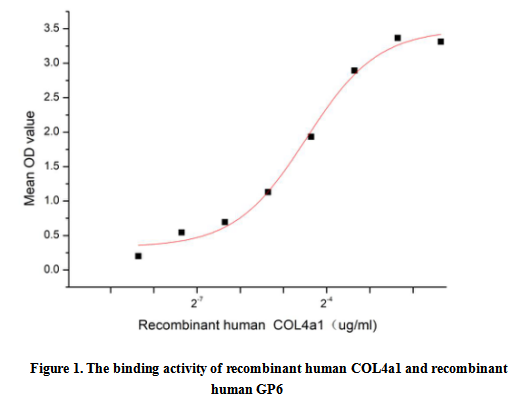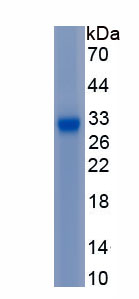Active Collagen Type IV Alpha 1 (COL4a1) 

COL4-A1; Arresten; Collagen Alpha-1(IV)chain
- UOM
- FOB US$ 272.00 US$ 680.00 US$ 1,360.00 US$ 4,080.00 US$ 10,200.00
- Quantity
Overview
Properties
- Product No.APA149Hu01
- Organism SpeciesHomo sapiens (Human) Same name, Different species.
- ApplicationsCell culture; Activity Assays.
Research use only - DownloadInstruction Manual
- CategoryMetabolic pathway
- Buffer FormulationPBS, pH7.4, containing 0.01% SKL, 5% Trehalose.
- Traits Freeze-dried powder, Purity > 80%
- Isoelectric Point6.7
Sign into your account
Share a new citation as an author
Upload your experimental result
Review

Contact us
Please fill in the blank.
Activity test

Collagen Type IV Alpha 1 (COL4a1), a secreted glycoprotein ,is a member of the type IV collagen family. COL4a1 is the major structural component of glomerular basement membranes (GBM), forming a 'chicken-wire' meshwork together with laminins, proteoglycans and entactin/nidogen. It can inhibit angiogenesis and tumor formation, and specifically inhibit endothelial cell proliferation, migration and tubule formation. COL4A1 mutations can remain asymptomatic or cause devastating disease. Neonates and children may present with porencephaly, intracerebral hemorrhage, or hemiparesis, whereas adults tend to develop intracranial aneurysms or retinal arteriolar tortuosities. Glycoprotein VI (GP6) has been identified as an interactor of COL4a1, thus a functional binding ELISA assay was conducted to detect the interaction of recombinant human COL4a1 and recombinant human GP6. Briefly, COL4a1 was diluted serially in PBS with 0.01% BSA (pH 7.4). Duplicate samples of 100 μl were then transferred to GP6-coated microtiter wells and incubated for 1h at 37℃. Wells were washed with PBST and incubated for 1h with anti-COL4a1 pAb, then aspirated and washed 3 times. After incubation with HRP labelled secondary antibody for 1h at 37℃, wells were aspirated and washed 5 times. With the addition of substrate solution, wells were incubated 15-25 minutes at 37℃. Finally, add 50 µL stop solution to the wells and read at 450/630 nm immediately. The binding activity of recombinant human COL4a1 and recombinant human GP6 was shown in Figure 1, the EC50 for this effect is 0.05 ug/mL.
Usage
Reconstitute in 10mM PBS (pH7.4) to a concentration of 0.1-1.0 mg/mL. Do not vortex.
Storage
Avoid repeated freeze/thaw cycles. Store at 2-8°C for one month. Aliquot and store at -80°C for 12 months.
Stability
The thermal stability is described by the loss rate. The loss rate was determined by accelerated thermal degradation test, that is, incubate the protein at 37°C for 48h, and no obvious degradation and precipitation were observed. The loss rate is less than 5% within the expiration date under appropriate storage condition.
Increment services
-
 BCA Protein Quantification Kit
BCA Protein Quantification Kit
-
 Molecular Mass Marker for Protein
Molecular Mass Marker for Protein
-
 Monoclonal Antibody Customized Service
Monoclonal Antibody Customized Service
-
 Polyclonal Antibody Customized Service
Polyclonal Antibody Customized Service
-
 Protein Activity Test Experiment Service
Protein Activity Test Experiment Service
-
 Electrophoretic Mobility Shift Assay (EMSA) Experiment Service
Electrophoretic Mobility Shift Assay (EMSA) Experiment Service
-
 Buffer
Buffer
-
 Lentivirus Packaging Experiment Service
Lentivirus Packaging Experiment Service
-
 Adenovirus Packaging Experiment Service
Adenovirus Packaging Experiment Service
-
 Real Time PCR Experimental Service
Real Time PCR Experimental Service
-
 Spike RBD Protein (S-RBD)
Spike RBD Protein (S-RBD)
-
 Protein G
Protein G
-
 Protein A
Protein A
Citations
- Peritoneal Dissemination Requires an Sp1-Dependent CXCR4/CXCL12 Signaling Axis and Extracellular MatrixâDirected Spheroid FormationPubmed:26744523
- miR-146a regulates glucose induced upregulation of inflammatory cytokines extracellular matrix proteins in the retina and kidney in diabetes10.1371
- Endothelin-1 traps potently reduce pathologic markers back to basal levels in an in vitro model of diabetes
- Epitope recognized by anti-glomerular basement membrane (GBM) antibody in a patient with repeated relapse of anti-GBM diseasePubmed: 30817909
- In vivo studies demonstrate that endothelin-1 traps are a potential therapy for type I diabetes
- Curcumin Analogs Reduce Stress and Inflammation Indices in Experimental Models of DiabetesPubmed: 31920992







